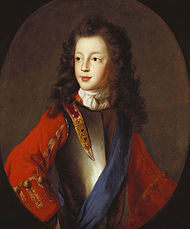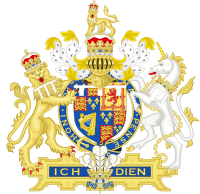| James Francis Edward | |
|---|---|

| |
| James Francis Edward Stuart, "The Old Pretender" | |
| Prince of Wales | |
| Preceded by | James II and VII |
| Succeeded by | Charles "III" |
| Personal details | |
| Born | 10 June 1688 St. James's Palace, London, Kingdom of England |
| Died | 1 January 1766 (aged 77) Palazzo Muti, Rome, Papal States |
| Spouse(s) | Maria Klementyna Sobieska |
James Francis Edward, Prince of Wales (the Chevalier de St George, "The King Over the Water", "The Old Pretender" or "The Old Chevalier"; 10 June 1688 – 1 January 1766) was the English son of the soon-to-be-deposed James II of England and Ireland (James VII of Scotland). As such, he claimed the English, Scottish and Irish thrones (as James III of England and Ireland and James VIII of Scotland) from the death of his father in 1701, when he was recognised as king of England, Scotland and Ireland by his cousin Louis XIV of France. Following his death in 1766, he was succeeded by his son Charles Edward Stuart in the Jacobite Succession. Had his father not been deposed, there would have been only two monarchs during his lifetime; his father and himself. In reality, there were seven; his father, William III, Mary II, Anne, George I, George II and George III. Although the ruling Protestant Stuarts died out with his half-sister, Queen Anne, the last remaining Stuarts were James and his sons, and their endeavours to reclaim the throne while remaining devoted to their Catholic faith are remembered in history as Jacobitism.
Birth and childhood[]

James Francis Edward, about 1703, portrait in the Royal Collection attributed to Alexis Simon Belle
From the moment of his birth, on 10 June 1688, at St. James's Palace, the prince was the subject of controversy. He was born to the reigning king, James II of England and Ireland (VII of Scotland), and his Roman Catholic second wife, Mary of Modena, and as such was automatically Duke of Cornwall and Duke of Rothesay, among other titles.
The Wars of Religion were fresh in the minds of the populace, and many British feared a revived Catholic dominance of the government. James II had two adult daughters from his first marriage, the future queens Princess Mary and Princess Anne, who had been raised as Protestants. As long as there was a possibility of one of them succeeding him, his opponents saw his rule as only a temporary aberration. When people began to fear that James's second wife, Mary, would produce a Catholic son and heir, a movement grew to replace him with his elder daughter Princess Mary and his son-in-law/nephew, William of Orange.
When the young prince was born, rumours immediately began to spread that he was an impostor baby, smuggled into the royal birth chamber in a warming pan. The true child of James and Mary was allegedly stillborn.[1] In an attempt to scotch this myth, James published the testimonies of over seventy witnesses to the birth.[2]
On 10 December, within six months of his birth, Mary of Modena took baby James to France, worried about his safety, while his father continued to fight (unsuccessfully) to retain his crown.[citation needed] James and his sister Louisa Maria were brought up in France[citation needed]. There, James was recognised by his cousin, King Louis XIV of France, as the rightful heir to the English and Scottish thrones and became the focus for the Jacobite movement.[citation needed]
Struggle for the throne[]
On his father's death in 1701, James declared himself King, as King James III of England and VIII of Scotland and was recognised as such by France, Spain, the Papal States and Modena. These states refused to recognise William III, Mary II or Queen Anne as legitimate sovereigns. As a result of his claiming his father's lost thrones, James was attainted for treason in London on 2 March 1702, and his titles were forfeited under English law.[3]
Jacobite rising[]
Though delayed in France by an attack of measles, James attempted an invasion, trying to land at the Firth of Forth on 23 March 1708. The fleet of Admiral Sir George Byng intercepted his French ships, and in spite of James' tearful pleas, the French admiral refused to let him go ashore, choosing to retreat rather than risk a naval battle.
In August–September 1710 Queen Anne appointed a new Tory administration led by Robert Harley, who entered into a secret correspondence with the French Minister of Foreign Affairs, de Torcy, and claimed to desire James's restoration to the throne if James converted to Protestantism.[2] However, a year later the British government pushed for James's expulsion from France as a precondition for a peace treaty with France. In accordance with the Treaty of Utrecht (1713), Harley and the Secretary of State, Lord Bolingbroke, colluded with the French in exiling James to the Duchy of Lorraine which bordered France.[2]
Queen Anne became severely ill at Christmas 1713 and seemed close to death. In January 1714 she recovered but clearly had not much longer to live. Through de Torcy and his London agent, Abbé François Gaultier, Harley kept up the correspondence with James, and Bolingbroke had also entered into a separate correspondence with him. They both said to James his conversion to Protestantism would facilitate his restoration. However James, a devout Catholic, said to Torcy: "I have chosen my own course, therefore it is for others to change their sentiments".[2] In March came James's refusal to convert and Harley and Bolingbroke came to see James's restoration as infeasible, though they maintained their correspondence with him.
As a result, in August 1714, James second-cousin, George of Hanover, a German-speaking Protestant became King of the recently created Kingdom of Great Britain.
The Fifteen[]

The Old Pretender lands in Scotland after Sheriffmuir. An 18th-century engraving.
In the following year Scottish Jacobites started "The 'Fifteen" Jacobite rising in Scotland, aimed at putting "James III and VIII" on the throne. On 22 December 1715, James finally set foot on Scottish soil, following the indecisive Battle of Sheriffmuir (13 November 1715), but was disappointed by the strength of support he found. Timid and clearly uncomfortable with crowds, James failed to establish himself as a credible leader. He soon fell ill with fever, his illness made more severe by the icy Scottish winter. Instead of going through with plans for a coronation at Scone, he returned to France, sailing from Montrose on 5 February 1716. He was not welcomed on his return: his patron, Louis XIV, had died on 1 September 1715 and the French government found him a political embarrassment.
Life as Pretender[]
Pope Clement XI offered James the Palazzo Muti in Rome as his residence, and he accepted. Innocent XIII, like his predecessor, showed much support. Thanks to the mediation of a close friend of his, Cardinal Filippo Antonio Gualterio, James was granted a life annuity of eight thousand Roman scudi. Such help enabled him to organise a Roman Jacobite court, where he lived in splendor yet continued to suffer from fits of melancholy and depression. As the years passed, young "Roving Jamie" became known as "Old Mr. Misfortunate." He grew increasingly feeble and despondent, taking on the appearance and behaviour of a much older man. The cruel and unflattering nickname reflected both his sad demeanor and the disappointment of his hopes. Nevertheless, he remained well treated in Rome until the end of his life. The Pope's cousin, Francesco Maria Conti of Siena, was the Gentiluomo di camera (Chamberlain).
Marriage[]
Louise Adélaïde d'Orléans (Mademoiselle d'Orléans), daughter of Philippe II, Duke of Orléans, was at one time suggested as a wife for James Francis Edward Stuart, but nothing came of it.
On 3 September 1719, James Francis Edward Stuart married Maria Clementina Sobieska (1702–35), granddaughter of King John III Sobieski of Poland (and sister of Maria Karolina Sobieska). The wedding was held in the chapel of the Episcopal Palace in Montefiascone (near Viterbo).
They had two sons:
- Charles Edward Stuart (31 December 1720 – 31 January 1788), nicknamed "Bonnie Prince Charlie"
- Henry Benedict Stuart (11 March 1725 – 13 July 1807), Cardinal of the Roman Catholic Church
Bonnie Prince Charlie[]
Following James's failure, attention turned to his courageous and charismatic son Charles,
"the Young Pretender", whose rebellion of 1745 came much closer to success than his father's. With the failure of this second rebellion, however, the Stuart hopes of regaining the British throne were effectively destroyed. James and Charles later clashed repeatedly, and relations between them broke down completely when James played a role in the election of his son Henry as a Cardinal (the celibacy required meaning that Henry would not have any legitimate children and thus could not carry on the line of succession), infuriating Charles, who had not been consulted.
In 1759 the French government briefly considered a scheme to have James crowned King of Ireland, as part of their plans to invade Britain, but the offer was never formally made to James. Several separate plans also involved Charles being given control of a French-backed independent Ireland.

Tomb of James Francis Edward Stuart and his two sons in St. Peter's Basilica.
Death[]
James died in Rome on 1 January 1766, and was buried in the crypt of St. Peter's Basilica at the Vatican. His burial is marked by the Monument to the Royal Stuarts. Refusing to recognise James's eldest son Charles, from 14 January the Papacy instead accepted the Hanoverian dynasty as the legitimate rulers of Britain and Ireland. This led on to the slow reform of the anti-Catholic "Penal laws" in Britain and Ireland.
In 1792 the Papacy specifically referred to George III as the King of Great Britain and Ireland, leading to a protest from James's second son, Henry, who was then the Jacobite claimant.[4]
James's 64 years, 3 months and 16 days as the Jacobite pretender to the thrones of England, Scotland and Ireland lasted longer than the reigns of any recognised monarch of those kingdoms or their successor states. To date, the longest serving British monarch is Queen Victoria, who reigned for 63 years, 7 months and 2 days. To surpass the record set by the titular James III, the current monarch Queen Elizabeth II would need to remain on the throne until at least 23 May 2016.
Titles and honours[]

Coat of arms of James Francis Edward Stuart
James was created Prince of Wales on 4 July 1688.[5]
Honours[]
- Jacobite, KG: Knight of the Garter, 1692–1766
Arms[]
As Prince of Wales, James bore a coat of arms consisting of those of the kingdom, differenced by a label argent of three points.[6]
Ancestry[]
| Ancestors of James Francis Edward Stuart | ||||||||||||||||||||||||||||||||||||||||||||||||||||||||||||||||||||||||||||||||||||||||||||||||||||||||||||||||||||||||||||||||||||||||||||||||||||||||||||||||||||||||||||||||||||||||||||||||||||||||||||||||||||||||||||||||||||||||||||||||||||||||||||||||||||||||||||||||||||||||||||||||||||||||||||||||||||||||||||||||||||||||||||||||||||||||||||||||||||||||||||||||||||||||||||||||||||||||||||||||||||||||||||||||||||||||||||||||||||||||||||||||||||||||||||||||||||||||||||||||||||||||||||||||||||||||||||||||||
|---|---|---|---|---|---|---|---|---|---|---|---|---|---|---|---|---|---|---|---|---|---|---|---|---|---|---|---|---|---|---|---|---|---|---|---|---|---|---|---|---|---|---|---|---|---|---|---|---|---|---|---|---|---|---|---|---|---|---|---|---|---|---|---|---|---|---|---|---|---|---|---|---|---|---|---|---|---|---|---|---|---|---|---|---|---|---|---|---|---|---|---|---|---|---|---|---|---|---|---|---|---|---|---|---|---|---|---|---|---|---|---|---|---|---|---|---|---|---|---|---|---|---|---|---|---|---|---|---|---|---|---|---|---|---|---|---|---|---|---|---|---|---|---|---|---|---|---|---|---|---|---|---|---|---|---|---|---|---|---|---|---|---|---|---|---|---|---|---|---|---|---|---|---|---|---|---|---|---|---|---|---|---|---|---|---|---|---|---|---|---|---|---|---|---|---|---|---|---|---|---|---|---|---|---|---|---|---|---|---|---|---|---|---|---|---|---|---|---|---|---|---|---|---|---|---|---|---|---|---|---|---|---|---|---|---|---|---|---|---|---|---|---|---|---|---|---|---|---|---|---|---|---|---|---|---|---|---|---|---|---|---|---|---|---|---|---|---|---|---|---|---|---|---|---|---|---|---|---|---|---|---|---|---|---|---|---|---|---|---|---|---|---|---|---|---|---|---|---|---|---|---|---|---|---|---|---|---|---|---|---|---|---|---|---|---|---|---|---|---|---|---|---|---|---|---|---|---|---|---|---|---|---|---|---|---|---|---|---|---|---|---|---|---|---|---|---|---|---|---|---|---|---|---|---|---|---|---|---|---|---|---|---|---|---|---|---|---|---|---|---|---|---|---|---|---|---|---|---|---|---|---|---|---|---|---|---|---|---|---|---|---|---|---|---|---|---|---|---|---|---|---|---|---|---|---|---|---|---|---|---|---|---|---|---|---|---|---|---|---|---|---|---|---|---|---|---|---|---|---|---|---|---|---|---|---|---|---|---|---|---|---|---|---|---|---|---|---|---|---|---|---|---|---|---|---|---|---|---|---|---|---|---|---|---|---|---|---|---|---|---|---|---|---|---|---|---|---|---|---|---|---|---|---|---|---|---|---|---|---|---|---|---|---|---|---|---|---|---|---|---|---|---|---|---|---|---|---|---|---|---|---|---|---|---|
| ||||||||||||||||||||||||||||||||||||||||||||||||||||||||||||||||||||||||||||||||||||||||||||||||||||||||||||||||||||||||||||||||||||||||||||||||||||||||||||||||||||||||||||||||||||||||||||||||||||||||||||||||||||||||||||||||||||||||||||||||||||||||||||||||||||||||||||||||||||||||||||||||||||||||||||||||||||||||||||||||||||||||||||||||||||||||||||||||||||||||||||||||||||||||||||||||||||||||||||||||||||||||||||||||||||||||||||||||||||||||||||||||||||||||||||||||||||||||||||||||||||||||||||||||||||||||||||||||||
See also[]
- Monument to the Royal Stuarts
- Touch Pieces The cure of Scrofula or the King's Evil
- Correspondence with James the Pretender (High Treason) Act 1701 Parliament's response to his claim to the throne
Notes and sources[]
| Wikimedia Commons has media related to James Francis Edward Stuart. |
- ↑ Margaret McIntyre, Mary II (1662–1694), in Anne Commire (ed.), Women in World History, vol. 10 (2001), ISBN 0-7876-4069-7, p. 516
- ↑ 2.0 2.1 2.2 2.3 James Edward Gregg, 'James Francis Edward (1688–1766)', Oxford Dictionary of National Biography, Oxford University Press, 2004; online edn, May 2012, accessed 23 June 2013.
- ↑ Complete Peerage: "Duke of Cornwall".
- ↑ Vaughan, Herbert (1906). The Last of the Royal Stuarts: Henry Stuart, Cardinal Duke of York. London: Methuen. pp. 212–214. http://www.jacobite.ca/documents/17921104.htm.
- ↑ "The Prince of Wales – Previous Princes". Princeofwales.gov.uk. http://www.princeofwales.gov.uk/personalprofiles/theprinceofwales/abouttheprince/previousprincesofwales/. Retrieved 2 May 2010.
- ↑ Francois R. Velde. "Marks of Cadency in the British Royal Family". Heraldica.org. http://www.heraldica.org/topics/britain/cadency.htm. Retrieved 2 May 2010.
The original article can be found at James Francis Edward Stuart and the edit history here.